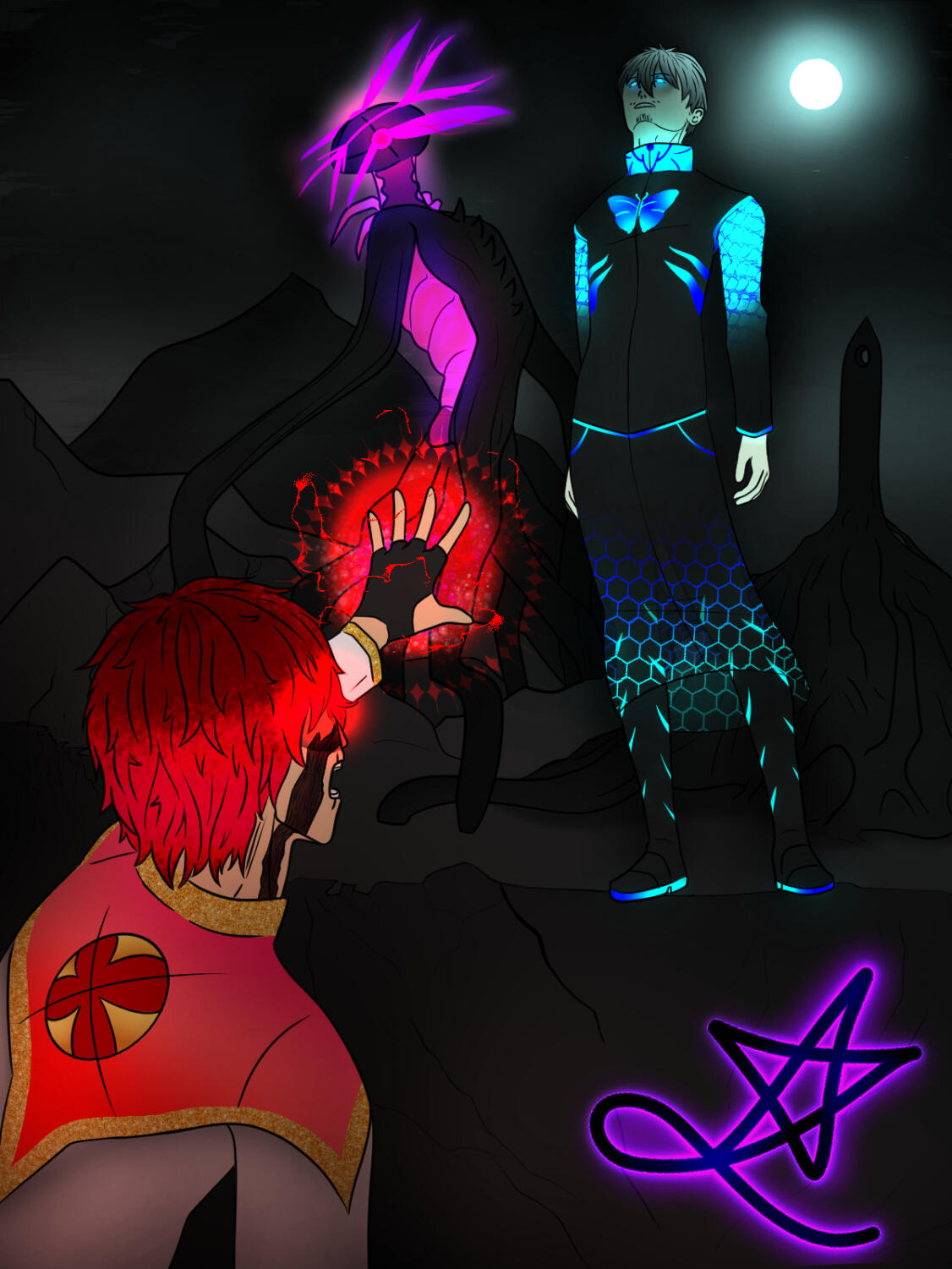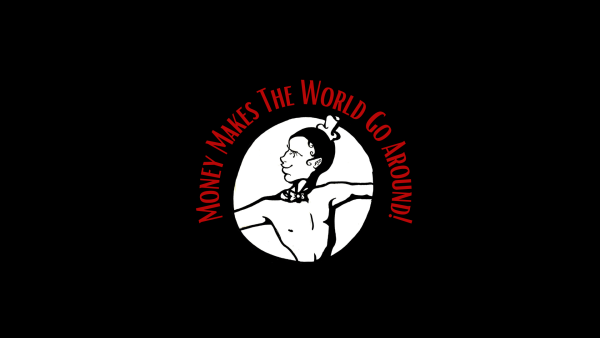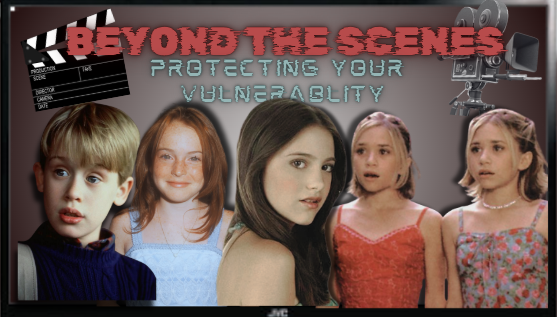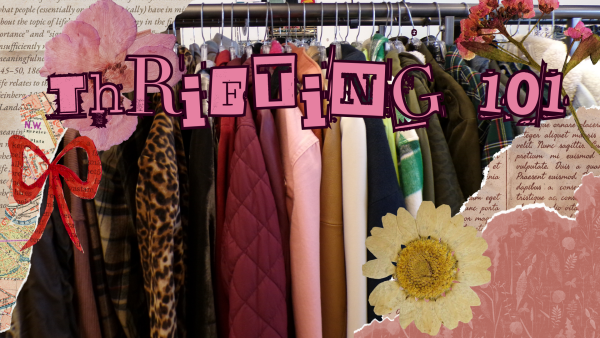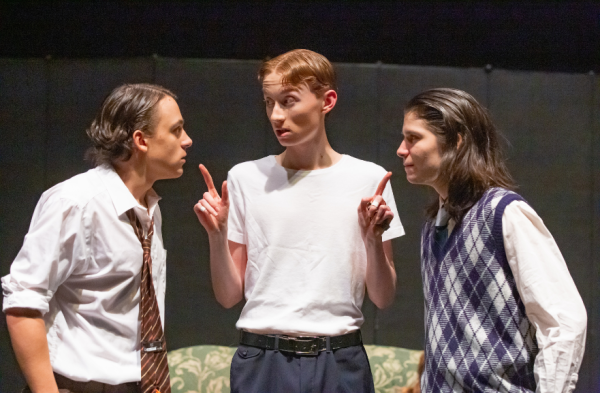The Villain’s Descent
This Ain’t Your Hero’s Average Journey
Hero Fallen, Villain Rising. Original artwork by: Carter Bernard.
Take any modern western media and, more often than not, it follows The Hero’s Journey: a story template that turns a protagonist into “the hero” in one twelve-hour progression, based on Joseph Campbell’s research into Greek myths. The Hero’s Journey sparked a conversation about how we create hero-driven narratives. In all its versions, The Hero’s Journey gained praise for being able to fit any genre or hero archetype, working best for protagonists forced into action and falling into heroics. However, a clear problem arises: not every protagonist is a hero, and not every villain is as simple as they seem.
Some have attempted to make their protagonists fit into The Hero’s Journey, and some made it work, but most struggle. That is because The Hero’s Journey’s nature is growth and support; heroes fail and get back up again as a more mature person that learns from the experience. So it is only natural that there should be a mirrored version of The Hero’s Journey, one that focuses on the decline, rejection, and what it takes for a regular person, cut from the same cloth as a hero, to be pushed into Villainy.
Some stories have already done this method of narrative diversion, others will continue to attempt it, but in Western media, it is rare to find a story that has a real villain before they gained power; and doesn’t center around redemption, or doesn’t contain jarring inaccuracies, present in most serial killer/overlord type protagonists. Stories, where characters grow into the villain and tell that story well, are not too present in mainstream media, something half-hearted villain stories do not struggle with. So here’s an alternative: if you want to get dirty, corrupted, or at the very least morally gray, then you take The Villain’s Descent.
Why do we need The Villain’s Descent? It offers Perspective. The difference between a struggle being part of self-improvement or some kind of punishment can truly be up to the person. It’s the same thing with making characters: in The Hero’s Journey, we are supposed to see the obstacles as progression no matter how devastating, and, in The Villain’s Descent, each mishap is a cruel backslide no matter how minimal. This subtle difference in perspective is what makes or breaks the entire theme and purpose of a story.
A final consideration before we explore The Villain’s Descent’s thirteen hours: Who would you be as a villain, really? Could you handle it if your world was broken down, and you were forced over and over to choose between your life and the ones who risk it? What would be the breaking point? Would doing bad things get easier? Could you survive hell long enough to embrace the darkness? If today was the day it started, what would need to happen for you to fall down the path of villainy? Keep this in mind when writing your characters. We’re not all as clean as we’d like to be.
1st Hour – Flawed Ordinary World
They open their eyes to another day and today is just like any other—that’s the problem. Our protagonist is an ordinary person, but they live in a flawed world. Perhaps it’s abuse, neglect, or suppression for being part of a marginalized group. Whatever the reason, they have been broken down. Maybe they seem normal, or maybe the problem is that they so obviously aren’t. In the end, the protagonist is hurting, vulnerable, “off.” Where a hero perseveres beyond their flawed world a villain will not look past it, because, in their eyes, it costs them too much.
It is very important to consider what “costs too much,” to our protagonists. In some cases, it could be civil freedoms, hence why a lot of villains in modern western media end up being part of real or fictional marginalized groups, or it could be something as trivial as being forced to say hello to someone in line as they wait for coffee because of social standards; these very different answers have deep-seated implications into our protagonists’ psyche and mental stability, it can also be used to make statements about the society itself. Is the society/governing power truly an oppressing force, or a minor inconvenience, or is it really the citizens behind it all? Answer these questions in your own time, but make sure you eventually answer them.
It’s also very common for our protagonist to hold a victim mentality from the very beginning, others may develop it during The Villain’s Descent.
2nd Hour – Tempted from Safety
Despite living in a flawed world, where sacrifice is constant, the protagonist has found some certainty, perhaps for chaos itself. This certainty has kept them from losing their footing near the edge of a rather sheer cliff. That ends today.
It’s subtle, but today they teetered too close to the edge. The reason can be good or bad: increased bills, blackmail, going on a date, up for promotion, a letter from dream college, wedding anniversary, etc. The edge represents tempting fate, getting too close can reap rewards or cause you to fall. Up to this point, our protagonist has worked hard to avoid the edge altogether, but today they just got too close.
It’s up to you if they were forced on the edge or tempted by it, and this will cause one of two reactions from our protagonist: When forced, our protagonist has their heels off the edge, they’re panicking and trying to regain their balance, swinging their arms frantically just barley stopping the fall. When tempted, they try their best to peer over the edge, on all fours they try to lean over as far as possible while holding their ground, keeping their calm through curiosity.
3rd Hour – Dark Agent
The dark agent can be anything from a law, animal, to a mugger; its purpose is random. Whatever happens to the protagonist could have happened to anyone, but it just had to happen to them. Just as they’re about to regain balance, or stop peering over the edge, something bumps them. It’s so inconsequential to whatever caused it, but our protagonist’s chance for familiarity has been cast away and they start descending. They had always tried their best to avoid the edge, it just happened that this time, the one time they got too close, they got pushed. Unprepared they’re going to learn how much it costs to survive in the darkness.
The dark agent is a unique hour in that it can reappear multiple times in the story and directly replaces the guidance a mentor provides, specifically acting to further disorient our protagonist. It can take the shape of a mentor or familiar face; however, the actions of the dark agent will always push our unwitting protagonist off the edge down a path of darkness.
4th Hour – Forced Adaptation
The time for second-guessing and indifference is over. It’s do or die. Our protagonist is past the cliff’s edge, where any moment can end a life (or something of equal weight, in their perspective). They put aside their morals to make the tough decisions needed to survive. Once they meet their basic survival needs, our protagonist will begin aiming to return to the edge.
As long as they want to survive, they will corrupt themselves to do it. Sure, their actions might be selfish, but they need to believe that it’s worth it; to be safe, to get out of the darkness, getting back to the edge is worth sacrificing the “good” in them.
A comfort zone is a luxury they never really had, but these drastic decisions will haunt them. Our protagonist doesn’t need to believe that they are deserving of a better life, they just need to fear staying in the darkness.
These “drastic decisions” are up to you, but what makes them drastic is that they are sacrifices. Not unlike the sacrifices that our protagonist’s Flawed Ordinary World forced them to make, but in this case, they aren’t used to it. The consequences of those drastic decisions have to be preferable to what their other options are at the time, but still damaging enough to have our protagonist prefer their previous mistreatment in the Flawed Ordinary World.
5th Hour – Attempt at Normalcy
This is a very important stage. The things they experienced in the previous hour forced them to evolve. It may even open their eyes to more injustice than they were aware of since the beginning, it will become both a source of determination and indignation. Their time in the darkness has changed our protagonist’s personality, they met their survival needs, they adapted, but they need to go further.
It becomes easier to make morally dark decisions; after all, it’s just what needs to be done—or so our protagonist chooses to believe. For a short time, they purposely go deeper into the darkness, gaining resources, their final attempt to climb past the edge and regain their footing out of the darkness. Then before they know it, all of their fighting to get away from the bottom has led them to the top. They can actually leave the darkness.
Make sure you emphasize how close they are, perhaps they see it right before their eyes and it’s only one more step before their corruption becomes worth it.
6th Hour – Thrown Off Cliff
However, right at the moment of salvation, they are denied. Perhaps it was another Dark Agent or someone in power that didn’t believe our protagonist was worth saving. Redemption has been denied as our protagonist jumps to grab the edge. They don’t just fall down, they have been thrown off the cliff.
7th Hour – Falling / Torture
The previous hours are like descending peaks on a cliff. Our protagonist slips off the edge and has to stop themselves from going deeper into darkness and climb back up the side. In this case, then, they have been completely thrown away from its side. With nothing to grab onto, they watch as all their work, all that forced corruption and adaptation, becomes worth nothing.
Completely forsaken, they fall past the edge, past the darkness they already knew before, and farther and farther they go.
8th Hour – Call in the Void
People always talk about rock bottoms, but it seems like they keep falling. When a person is subject to such an extreme amount of stress that their mind can’t cope, their mind tries to escape through dissociation. This happens during grief, torture, and neglect; there are different kinds of dissociating, but as long as they survive, their mind doesn’t need them to be functional.
This can’t last forever: reliving the moments in their head, asking themselves questions, doing anything to distract from their situation, our victim needs a reason. Wouldn’t you?
Whatever they can come up with, they need a reason this is happening, a reason for this hurt. Then they hear it, a voice in the void. It doesn’t really have to be a voice, of course, it could be another dark agent or a small revelation. Whatever it is, the voice provides their first comfort in who knows how long, they’ve been falling forever.
This voice will start providing answers to our victim’s questions, and the voice will also ask its own. Soon, our victim comes to conclusions and a narrative becomes clear: none of this ever their fault, they were forced to be a victim, someone else is to blame, the world, their family, a butterfly, it doesn’t matter. The focus of their blame will become a scapegoat for their previous actions, and a justification for their future ones. It doesn’t matter if some of our victims’ decisions were their own, they believe they had no choice in any form.
9th Hour – Whatever It Takes
When the victim realizes they can blame something, it becomes easier to hear the voice. It probed for details about those who hurt the victim, their flaws, their hypocrisy, their injustices against them until it asks a final question: “What are you going to do about it?”
You must seriously consider this question, what is your character going to do about it? They must have a goal, anything you like, and now we have our protagonist’s answer. For some protagonists, the conclusion can take a moment, but to fully achieve their goal, their answer will be, “Whatever it takes…”
A common trope in this section is that the victim/protagonist will continuously rile themselves until they are sure with this answer. Usually, the voice asks again, and the victim answers a little louder. Again, it asks. The victim barks back. The voice screams the question at our victim and finally the last of the walls in their minds shattered.
They scream their answer for anyone who can hear, “WHATEVER IT TAKES!”
We need to make sure there is no shadow of a doubt in our protagonist’s minds that they can do “what needs to be done” to achieve this new goal they’ve set for themselves.
10th Hour – Embraced Descent
Whatever the voice was doesn’t matter. Our victim’s old self is now dying, everything they did to do better was for nothing, so now they are going to embrace it. Whatever it takes is the only thought that repeats itself as our victim starts falling faster. As they plunge themselves deeper until and deeper our protagonist will finally hit their rock bottom, which only came to fruition through their acceptance of corruption.
Upon impact, all their “good” dies with the old self, refusing to be the world’s victim any longer. They were hurt, so why shouldn’t they hurt everyone else? They are the protagonist, they won’t be the victims anymore, now they’re the villain of this story. They need to believe that, they need to see reality in such a way that this is wholly their decision as a final rejection of the world.
11th Hour – Metamorphosis
A transformation takes place at the bottom of the cliff. Our protagonist, previously a victim, sheds all their armor. At this point, they accept their belief that the whole world is out to get them, so they might as be the loudest, most awfully authentic version of themselves possible. They disregard their world’s standards. Who cares about their behavior, their gender, clothes, their orientation, their race, their looks. They aren’t going to spare any expense dimming themselves for the sake of others. In fact, they’ll want to make them all jealous!
All good villains have a transformation scene and this is the moment to go wild. It’s time to distort our fledgling villain’s appearance and personality beyond recognition. Give them new hair, costumes, powers. If you wish, give them a new physical form. To solidify their identity, they must have a new name, a new title, some kind of moniker that the audience will see as a final blow.
Having nothing to lose, our Villain challenges the world and its false heroes. With their new power, dark allies, or an unbreakable conviction, the villain is willing to destroy everything for their goal.
The final step of their re-branding is here. After so many attempts to climb up the cliff, our villain is going to level it, bring everyone down to their depths of depravity. This show of force will have to make their foes take them seriously. It could be a statement, an attack, maybe just starting a conversation in public, but it must be seen as an act of war.
12th Hour – No Return
The heroes still won’t listen, the world still denies them the recognition they deserve. They might all try to appeal to the villain’s good side, thinking they can be redeemed. Or, they try to guilt them for all their misdeeds. Our villain isn’t swayed. Perhaps they laugh or become enraged since it’s a fact to them that everyone else is to blame. Even if there is pain lying underneath it all, this facade must be harder than steel, so much so that our villain never realizes they are affected by their pain.
When our villain gets a response, it won’t matter. Regardless of how they act in this scenario, our villain is looking for satisfaction in causing pain in those around them, at the very least their own form of “justice.” This is the moment we show our audience how far gone the villain is. Through an act of pure self-interest, we need to prove to our audience that the character has no chance of redemption. In the last few hours, our villain killed their old self, now they must kill someone else (this can be figuratively of course!).
The protagonist from the first hour should be scared of the person they’ve become. But that was so long ago, now is the final showdown. It’s time to finally see how this spiraling toxic self-destruction, nurtured by an equally messed up world, is going to end. In the final hour, you get to decide how they complete The Villain’s Descent.
13th Hour – Cataclysm
The final moment has passed, the dust is settling, the impact has been made, it’s abrupt and sudden, and just as unfulfilling as our villain’s life up to this point. On one hand, our villain dies. You may end their story with the end of their life, at best, by the hands of their choosing and, at worst, the work of a cruel irony. On the other hand, they can win. We have the villain win the battle they declared. But… what now? For a moment there is emptiness. What is the villain to do after this rush and high have ended? To fully commit to The Villain’s Descent, their satisfaction should not be satisfying. They look around at the world burning around them and see what “whatever it takes” really costs: collateral damage equal to the tragedy they suffered. That’s because The Villain’s Decent is supposed to end in destruction. Even if the Villain is happy with their ending, the audience shouldn’t be. We should mourn their loss and corruption. We can also come to hate them despite understanding their actions.
Night’s End – What Now?
This is my favorite part of The Villain’s Descent. After you’ve told your terribly tragic, gross, gritty, and horrifying tale, you can keep going. That is, if the villain we’ve created survived in the end. What actually happens when they ask themselves “What now?” an easy answer would be to end it all… or maybe they really do take over. Maybe the villain becomes the demon lord and forces of evil that are whispered about in fairy tales, maybe they spend the rest of their lives making a feeble attempt to redeem themselves. Or, what if, through all their destruction and chaos they end up creating a new protagonist? Your next character could be a villain, hero, or whoever is created from our previous protagonist’s story. I personally feel creating another story, where your old protagonist, the villain, is serving as the main antagonist for your new character could create a whole new depth and exploration of your previous themes. Can you imagine rooting and growing with Voldemort’s character before reading Harry Potter’s journey? How wonderfully messed up is that? It also opens up discussion for the cycle of violence, something the previous villain suffered from and possibly passed onto a new hero or villain.
Whatever you end up deciding, I hope you were really able to get into the mindset of a real villain since, in the end, they’re mostly just hurting people.
The Hero’s Journey is meant to inspire and spread hope, and The Villain’s Descent teaches us empathy—empathy for our enemies and for strangers since any one of us could be on the edge of A Villain’s Descent. So, try not to be someone’s Dark Agent. A hero strives for no one else to suffer the same pain they did, a villain will only spread the hurt they’ve experienced. We don’t all get to be heroes, but we can choose not to be villains.
Your donation will support the student journalists of Huntington Beach High School. Your contribution will allow us to cover our annual website hosting costs.
Thank you for supporting our program!


